Close The Gap Community Guide
Archived
You are in an archived section of the website. This information may not be current.
This page was first created in December, 2012
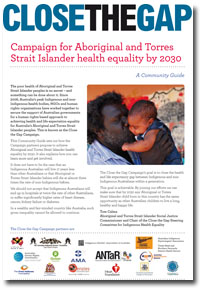 Close The Gap
Close The Gap
Campaign for Aboriginal and Torres Strait Islander health equality by 2030
![]() Download Community Guide in PDF [1.46MB]
Download Community Guide in PDF [1.46MB]
![]() Download Community Guide in WORD [82 KB]
Download Community Guide in WORD [82 KB]
- A Community Guide
- The problem
- The solution
- The Close the Gap Statement of Intent
- Developing a national plan for Aboriginal and Torres Strait Islander
health equality - A partnership for Aboriginal and Torres Strait Islander health equality
- The National Indigenous Health Equality Targets
- Get involved
A Community Guide
The poor health of Aboriginal and Torres Strait Islander peoples is no secret – and something can be done about it. Since 2006, Australia’s peak Indigenous and non- Indigenous health bodies, NGOs and human rights organisations have worked together to secure the support of Australian governments for a human rights based approach to achieving health and life expectation equality for Australia’s Aboriginal and Torres Strait Islander peoples. This is known as the Close the Gap Campaign.
This Community Guide sets out how the Campaign partners propose to achieve Aboriginal and Torres Strait Islander health equality by 2030. It also explains how you can learn more and get involved.
It does not have to be the case that an Indigenous Australian will live 17 years less than other Australians or that Aboriginal or Torres Strait Islander babies will die at almost three times the rate of non-Indigenous babies.
We should not accept that Indigenous Australians will end up in hospitals at twice the rate of other Australians, or suffer significantly higher rates of heart disease, cancer, kidney failure or diabetes.
In a wealthy and fair-minded country like Australia, such gross inequality cannot be allowed to continue. The Close the Gap Campaign’s goal is to close the health and life expectancy gap between Indigenous and non- Indigenous Australians within a generation.
This goal is achievable. By joining our efforts we can make sure that by 2030 any Aboriginal or Torres Strait Islander child born in this country has the same opportunity as other Australian children to live a long, healthy and happy life.
Tom Calma
Aboriginal and Torres Strait Islander Social Justice
Commissioner and Chair of the Close the Gap Steering
Committee for Indigenous Health Equality
The problem
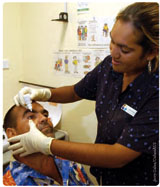
What is the cause of the Aboriginal and Torres Strait Islander health equality gap?
Over the last 50-years the health of Australians has improved significantly due to major advances in medical care and rising prosperity. Aboriginal and Torres Strait Islander Australians, however, have not shared in the same benefits.
The current 17-year life expectation gap is not a ‘normal’ state of events. It is the result of decades of neglect.
The 1967 Referendum, which enabled the federal government to take greater control over Indigenous affairs, was meant to be a starting point to turn around the poor health of the Aboriginal and Torres Strait Islander population.
Since then the health of Aboriginal people and Islanders has improved – but not enough to reach the health standards enjoyed by the broader community.
Today cardiovascular disease is the single biggest killer of Indigenous Australians. Other serious health problems include diabetes, respiratory diseases, musculoskeletal conditions, kidney disease and eye and ear problems.
These are all preventable.
Australia can expect to live
to an average age of 82 years,
Aboriginal and Torres Strait
Islander women can expect
to live to only 64.8 years.
The situation is even worse
for Indigenous Australian
men whose life expectancy
is just 59.4 years.
The main causes of health inequality are clear.
Aboriginal peoples and Torres Strait Islanders have less access to essential health services than other Australians. Too often they don’t get the health care they need, when and where they need it.
A particular problem facing Aboriginal and Torres Strait Islander communities is the relative lack of access to primary health care. Primary health care aims to prevent disease from occurring in the first place, or to detect it early. As a result, illnesses that could be prevented become chronic problems.
Overcrowded and poor quality housing in many Aboriginal and Torres Strait Islander communities, and limited access to fresh and healthy food, are also major contributors to health inequality.
The solution
suggest that one of the
wealthiest nations in
the world cannot solve
a health crisis affecting
less than three per cent
of its citizens.
Tom Calma
Aboriginal and Torres Strait
Islander Social Justice
Commissioner
Close the Gap – Achieving Indigenous health and life expectation equality by 2030
The key elements of the Close the Gap Campaign are:
- A comprehensive national plan of action that is properly resourced and that has the goal of achieving Indigenous health equality by 2030.
- A partnership with Indigenous peoples and their representatives.
- A targeted approach to achieving Indigenous health equality, focusing on a wide range of health conditions and health determinants.
- Support for Aboriginal Community Controlled Health Services.
And the good news is that Australian governments have already committed to this approach:
- through the Close the Gap Statement of Intent, signed by the Prime Minister in March 2008 (see inside): and
- at the December 2007 Council of Australian Governments meeting where Australian governments committed to closing the life expectancy gap within a generation, and halving the mortality gap between Aboriginal and Torres Strait Islander and non- Indigenous children under 5-years of age.
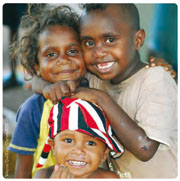 Progress has been slow, however, in turning these commitments into action. This remains the challenge of the Campaign partners. How you can get involved is set out on the back page of this brochure.
Progress has been slow, however, in turning these commitments into action. This remains the challenge of the Campaign partners. How you can get involved is set out on the back page of this brochure.
Building on success
The Close the Gap Campaign is built on evidence that shows that significant improvements in the health status of Aboriginal and Torres Strait Islander peoples can be achieved within short time frames.
Providing primary health care services to the Aboriginal and Islander population, particularly through Aboriginal Community Controlled Health Services, is likely to result in significant increases in life expectancy within a decade. The life expectancy of Native Americans increased by about nine years between the 1940s and the 1950s, and in New Zealand the life expectancy of Maori increased by about 12 years over the two decades from the 1940s to the 1960s, when such services were provided.
Programs targeting specific diseases also demonstrate that rapid improvements to Indigenous peoples’ health are possible. For example, death rates among Aboriginal people from pneumonia have dropped by 40 per cent since 1996, following the roll-out of pneumococcal vaccinations, The ‘Strong Babies, Strong Culture’ maternal health program has shown that significant reductions in the number of low birth weight babies can occur within a matter of years.
The Close the Gap Statement of Intent
Canberra, March 20, 2008
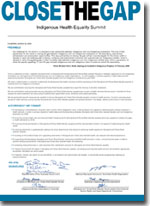
Preamble
Our challenge for the future is to embrace a new partnership between Indigenous and non-Indigenous Australians. The core of this partnership for the future is closing the gap between Indigenous and non-Indigenous Australians on life expectancy, educational achievement and employment opportunities. This new partnership on closing the gap will set concrete targets for the future: within a decade to halve the widening gap in literacy, numeracy and employment outcomes and opportunities for Indigenous children, within a decade to halve the appalling gap in infant mortality rates between Indigenous and non-Indigenous children and, within a generation, to close the equally appalling 17-year life gap between Indigenous and non-Indigenous when it comes to overall life expectancy.
Prime Minister Kevin Rudd, Apology to Australia’s Indigenous Peoples,
13 February 2008
This is a statement of intent – between the Government of Australia and the Aboriginal and Torres Strait Islander Peoples of Australia, supported by non-Indigenous Australians and Aboriginal and Torres Strait Islander and non-Indigenous health organizations – to work together to achieve equality in health status and life expectancy between Aboriginal and Torres Strait Islander peoples and non-Indigenous Australians by the year 2030.
We share a determination to close the fundamental divide between the health outcomes and life expectancy of the Aboriginal and Torres Strait Islander peoples of Australia and non-Indigenous Australians.
We are committed to ensuring that Aboriginal and Torres Strait Islander peoples have equal life chances to all other Australians.
We are committed to working towards ensuring Aboriginal and Torres Strait Islander peoples have access to health services that are equal in standard to those enjoyed by other Australians, and enjoy living conditions that support their social, emotional and cultural well-being.
We recognise that specific measures are needed to improve Aboriginal and Torres Strait Islander peoples’ access to health services. Crucial to ensuring equal access to health services is ensuring that Aboriginal and Torres Strait Islander peoples are actively involved in the design, delivery, and control of these services.
Accordingly we commit:
- To developing a comprehensive, long-term plan of action, that is targeted to need, evidence-based and capable of addressing the existing inequities in health services, in order to achieve equality of health status and life expectancy between Aboriginal and Torres Strait Islander peoples and non- Indigenous Australians by 2030.
- To ensuring primary health care services and health infrastructure for Aboriginal and Torres Strait Islander peoples which are capable of bridging thegap in health standards by 2018.
- To ensuring the full participation of Aboriginal and Torres Strait Islander peoples and their representative bodies in all aspects of addressing their health needs.
- To working collectively to systematically address the social determinants that impact on achieving health equality for Aboriginal and Torres Strait Islander peoples.
- To building on the evidence base and supporting what works in Aboriginal and Torres Strait Islander health, and relevant international experience.
- To supporting and developing Aboriginal and Torres Strait Islander community-controlled health services in urban, rural and remote areas in order to achieve lasting improvements in Aboriginal and Torres Strait Islander health and wellbeing.
- To achieving improved access to, and outcomes from, mainstream services for Aboriginal and Torres Strait Islander peoples.
- To respect and promote the rights of Aboriginal and Torres Strait Islander peoples, including by ensuring that health services are available, appropriate, accessible, affordable, and of good quality.
- To measure, monitor, and report on our joint efforts, in accordance with benchmarks and targets, to ensure that we are progressively realising our shared ambitions.
We are:
Signatures:
- Representative of the Australian Government
- National Aboriginal Community Controlled Health Organisation
- Congress of Aboriginal and Torres Strait Islander Nurses
- Australian Indigenous Doctors Association
- Indigenous Dentists Association of Australia
- Aboriginal and Torres Strait Islander Social Justice Commissioner,
Human Rights and Equal Opportunity Commission
On a separate sheet, the following signed this Statement of Intent: the Hon. Dr Brendan Nelson MP, Leader of the Opposition; Dr Rosanna Capolingua, President, Australian Medical Association; Ms Kate Carnell, Chief Executive Officer, Australian General Practice Network; Dr Vasantha Preetham, President, Royal Australian College of General Practitioners; Professor Napier Thomson, President, Royal Australasian College of Physicians; Mr Andrew Hewett, Executive Director, Oxfam Australia; Professor Michael Dodson, AM, Co-Chair, Reconciliation Australia; Ed Cooper, Get Up!; Gary Highland, National Director, Australians for Native Title and Reconciliation; Catherine Freeman, Catherine Freeman Foundation; Ian Thorpe, Ian Thorpe’s Fountain for Youth; and Mr Andrew Schwartz, President, Australian Doctors Trained Overseas Association.
Developing a national plan for Aboriginal and Torres Strait Islander health equality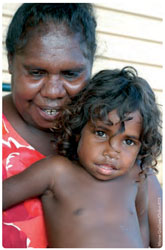
The Close the Gap Campaign partners organised the first-ever National Indigenous Health Equality Summit in Canberra in March 2008.
At this, the Prime Minister, the Minister for Health and Ageing, the Minister for Indigenous Affairs (representing the Australian Government), the Leader of the Opposition, and the Close the Gap Campaign partners signed the historic ‘Close the Gap Statement of Intent’. In this they committed to work in partnership with Aboriginal and Torres Strait Islander peoples and their representatives to achieve health and life expectation equality by 2030.
A central commitment in the Close the Gap Statement of Intent is for a comprehensive national plan for the achievement of Aboriginal and Torres Strait Islander health and life expectation equality by 2030 to be put in place as soon as possible. This should include:
- a coordinating body to oversee and guide the work of the many Australian, State and Territory government agencies responsible for delivering health services for the Aboriginal and Torres Strait Islander population.
- a monitoring body to ensure that the responsible government agencies are working effectively and that measurable progress is being made towards achieving the goal of health equality for Indigenous Australians.
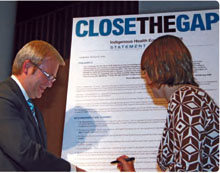
The plan should address all the factors that contribute to Indigenous health inequality. In particular, it should ensure:
- That the necessary primary health care – preferably delivered by Aboriginal Community Controlled Health Services – is in place by 2018.
- That an adequate number of health professionals (preferably Aboriginal and Torres Strait Islanders) are trained to deliver primary health care and other health care services to Indigenous communities.
- That the necessary housing, water supplies and waste systems to support the achievement of health equality are in place in Indigenous communities by 2018. Ensuring supplies of fresh healthy food are available by 2018 is also vital.
A partnership for Aboriginal and Torres Strait Islander health equality
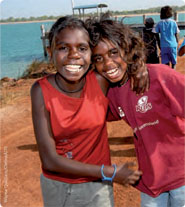 Aboriginal and Torres Strait Islander peoples and their representative bodies must be active participants with government in developing and implementing a national plan for Indigenous health equality.
Aboriginal and Torres Strait Islander peoples and their representative bodies must be active participants with government in developing and implementing a national plan for Indigenous health equality.
Aboriginal Community Controlled Health Services must be involved in health planning at the local and regional level with the National Aboriginal Community Controlled Health Organisation (NACCHO), and State/Territory NACCHO Affiliates at national and state and territory levels respectively. Additional partners would include the Indigenous health professional bodies and a national Indigenous representative body when it is established.
Aboriginal Community Controlled Health Services
Services operated and controlled by the Aboriginal communities they serve is the preferred model for the delivery of primary health care in the Close the Gap Campaign. These are called ‘Aboriginal Community Controlled Health Services’. They provide a vast range of care supporting complex health needs, and in a way that is culturally appropriate to the communities they operate in.
over 30 years and we have seen
governments come and go.
When there is a true collaboration
between governments and
their departments with our
organisations, in the development
and implementation of programs
that we believe are needed, that
will be the time when the gap
in health status will begin to be
closed.
Dr Mick Adams, Chair of the
National Aboriginal Community
Controlled Health Organisation
By knowing what any given communities health needs are and how to address them, they give strength to the community. In this way they are able to reach under-served Aboriginal patients, which is the key intent in closing the gap in Aboriginal disadvantage.
Because they are best placed to know what any given communities health needs are, the Close the Gap Campaign advocates Australian governments adopt a partnership approach with these services for regional and community planning for health equality.
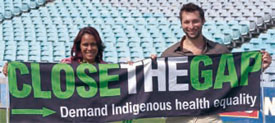
The National Indigenous Health Equality Targets
Specific targets and benchmarks should be used in the national plan for Aboriginal and Torres Strait Islander health equality. The Close the Gap Campaign partners have developed a comprehensive set of National Indigenous Health Equality Targets to guide this target-setting process. These were presented to the Australian Government in July 2008.
Developed by leading experts in Indigenous health, the targets are based on the need to address: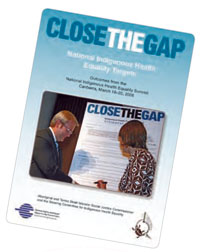
- the leading causes of Indigenous child mortality – including low birth weight, respiratory and other infections and injuries
- the leading contributing factors to the life expectancy gap – chronic disease, injuries and respiratory infections
- mental health and social and emotional well being – which are crucial to achieving better health.
The Close the Gap Campaign partners have developed targets to support the achievement of Indigenous health equality over many areas. Key targets include those to support:
- significant reductions in the rates of Aboriginal and Torres Strait Islander death and illness from diseases and chronic conditions;
- the delivery of the necessary primary health care services for health equality to Aboriginal and Torres Strait Islander communities, particularly by Aboriginal Community Controlled Health Services;
- big improvements to housing (so that it supports good health) in Aboriginal and Torres Strait Islander communities;
- a dramatic increase in the availability of fresh and healthy food supplies in Aboriginal and Torres Strait Islander communities; and
- significant reductions in the rate of smoking among Aboriginals and Torres Strait Islanders.
to implement a range
of targeted initiatives
which will deliver more
Indigenous doctors, nurses,
dentists, psychologists,
Aboriginal health workers
and allied health workers.
An Aboriginal and Torres
Strait Islander workforce
is critical to ‘close the gap’.
Dr Tamara Mackean
President, Australian
Indigenous Doctors’ Association
An additional set of targets is being developed by the Close the Gap Campaign partners to address the broad range of social and cultural factors that have a profound influence on the health of Indigenous Australians, such as housing, education, community safety, employment, community development, culture and language and contact with the criminal justice system.
Targets are important because they help maintain a focus on the achievement of Aboriginal and Torres Strait Islander health equality by 2030.
They will also help keep Australian governments accountable for the achievement of this goal.
For details on the National Indigenous Health Equality Targets – including timelines for their achievement and the resources required – go to www.humanrights.gov.au/ social_justice/health/targets.
Get involved
We stand at a watershed moment in the history of Indigenous health.
Campaign partners?
The Close the Gap Campaign
is led by a Steering Committee
(the partners), which includes:
Strait Islander Social Justice
Commissioner, Australian
Human Rights Commission
(Chair)
- National Aboriginal
Community Controlled
Health Organisation
- Australian Indigenous
Psychologists’ Association
- Australian Indigenous
Doctors’ Association
- Congress of Aboriginal
and Torres Strait Islander
Nurses
- Australian General
Practice Network
- Australian Medical
Association
- Australians for Native
Title and Reconciliation
- Cooperative Research
Centre for Aboriginal
Health
- The Fred Hollows
Foundation
- Heart Foundation
- Indigenous Dentists’
Association of Australia
- Menzies School of
Health Research
- Oxfam Australia
- Royal Australian College
of General Practitioners
- Royal Australasian
College of Physicians,
and Torres Strait and
Northern Peninsula District
Health Service.
Leadership from Aboriginal
peoples and their
representative bodies is a
hallmark of the Close the
Gap Campaign.
Through our members –
particularly the National
Aboriginal Community
Controlled Health
Organisation (NACCHO)
and the Indigenous health
professional bodies – we
draw on broader Aboriginal
community support. For
example, NACCHO
represents over 140
Aboriginal Community
Controlled Health Services
across Australia, each
governed by elected
community representatives.
The commitment of Australia’s governments to work in partnership with Indigenous peoples and their representatives to plan for Indigenous health equality by 2030 marks the start of an ambitious, but ultimately achievable, process to bring Indigenous health inequality to an end within our lifetimes.
To be successful, however, the Close the Gap Campaign will need support from all corners of the Australian community. You can get involved and play a part in consigning Indigenous health inequality to the history books.
Learn
- Visit www.humanrights.gov.au/social_justice/
health/ to find detailed information on the current
state of Indigenous health, along with a range of key
publications.
Subscribe
Join the ‘Indigenous Social Justice’ electronic mailing
list and keep up to date with the latest news: www.humanrights.gov.au/about/mailing_lists/
Contribute
Share examples of success stories in Indigenous
health – and be inspired by others:
www.antar.org.au/issues_and_campaigns/health/
success_stories
Participate
- Join with over 120,000 other Australiana and pledge
your support to the ‘close the gap’:
www.oxfam.org.au/campaigns/indigenous-health/ - Hold an event on National Close the Gap Day or write
to the Minister or your local MP
Visit
- Close the Gap; www.closethegap.com.au
- National Aboriginal Community Controlled Health
- Organisation; www.naccho.org.au
- Oxfam Australia; www.oxfam.org.au
- Australians for Native Title and Reconciliation;
www.antar.org.au
Contact us
Australian Human Rights Commission
Phone: +61 2 9284 9600, 1300 369 711
Fax: +61 2 9284 9611
Website: www.humanrights.gov.au
Email: paffairs@humanrights.gov.au
‘I believe that the basic attribute of mankind is to look after each other’.
Professor Fred Hollows AC
Financial support for this publication was provided by The Fred Hollows Foundation.
